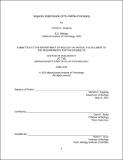Sequence determinants of pri-miRNA processing
Author(s)
Auyeung, Vincent C. (Vincent Churk-man)
DownloadFull printable version (18.20Mb)
Alternative title
Sequence determinants of pri-miRNA recognition and processing
Other Contributors
Massachusetts Institute of Technology. Dept. of Biology.
Advisor
David P. Bartel.
Terms of use
Metadata
Show full item recordAbstract
MicroRNAs (miRNAs) are short RNAs that regulate many processes in physiology and pathology by guiding the repression of target messenger RNAs. For classification purposes, miRNAs are defined as ~22 nt RNAs that are produced by the cleavage of endogenously transcribed hairpins. From a cellular perspective, however, miRNAs are the functional products of a multistep maturation pathway, and are thus defined by the ability of their precursors to enter this pathway. The cellular distinction between miRNA precursors and other hairpins is made in the first step of maturation, when the primary miRNA transcript (pri-miRNA) is cleaved by the Microprocessor, a complex containing Drosha, an RNase III enzyme, and an RNA-binding partner DGCR8. However, it is unclear how the Microprocessor distinguishes between these hairpins and authentic pri-miRNAs. In fact, C. elegans pri-miRNAs are not processed in human cells, illustrating the complexity of pri-miRNA recognition and processing. To systematically explore sequence determinants of pri-miRNA recognition, hundreds of billions of variants of human pri-miRNAs were generated, and millions of variants that were functional Microprocessor substrates were selected in vitro and sequenced. Analysis of the successful sequences revealed multiple determinants of pri-miRNA binding and cleavage, including hairpin secondary structure and primary sequence preferences in the terminal loop and flanking the hairpin. One of these determinants, a CNNC motif downstream of the Drosha cleavage site, is enriched in pri-miRNAs throughout bilaterian animals. Addition of the primary sequence motifs to C. elegans pri-miRNAs promoted their efficient processing in human cells, underscoring the importance of these determinants. The identification and characterization of specific motifs greatly expands the understanding of the features that cells use to recognize pri-miRNAs, and opens the door to future studies of pri-miRNA recognition in humans and other bilaterian animals. In addition, the approach is applicable to the exploration of a variety of functional RNA elements that have so far resisted functional dissection, including long noncoding RNAs and messenger RNA localization signals.
Description
Thesis (Ph. D.)--Massachusetts Institute of Technology, Dept. of Biology, 2012. This electronic version was submitted by the student author. The certified thesis is available in the Institute Archives and Special Collections. Cataloged from student submitted PDF version of thesis. Includes bibliographical references.
Date issued
2012Department
Massachusetts Institute of Technology. Department of BiologyPublisher
Massachusetts Institute of Technology
Keywords
Biology.